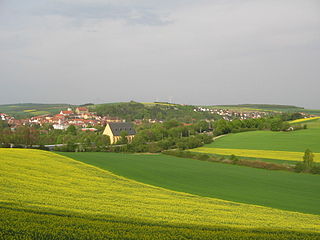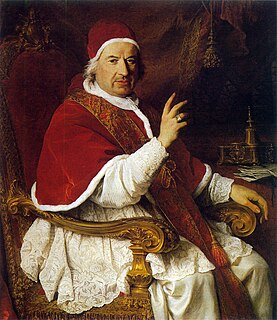
Johann Balthasar Neumann, usually known as Balthasar Neumann, was a German architect and military artillery engineer who developed a refined brand of Baroque architecture, fusing Austrian, Bohemian, Italian, and French elements to design some of the most impressive buildings of the period, including the Würzburg Residence and the Basilica of the Fourteen Holy Helpers.

The Prince-Bishopric of Würzburg was an ecclesiastical principality of the Holy Roman Empire located in Lower Franconia west of the Prince-Bishopric of Bamberg. Würzburg had been a diocese since 743. As definitely established by the Concordat of 1448, bishops in Germany were chosen by the canons of the cathedral chapter and their election was later confirmed by the pope. Following a common practice in Germany, the prince-bishops of Würzburg were frequently elected to other ecclesiastical principalities as well. The last few prince-bishops resided at the Würzburg Residence, which is one of the grandest baroque palaces in Europe.

The Schönborn family is a noble and mediatised formerly sovereign family of the former Holy Roman Empire.

Johann Philipp von Schönborn was the Archbishop-Elector of Mainz (1647–1673), the Bishop of Würzburg (1642–1673), and the Bishop of Worms (1663–1673).

Lothar Franz von Schönborn-Buchheim was the Archbishop-Elector of Mainz from 1694 to 1729 and the Bishop of Bamberg from 1693 to 1729. As Archbishop of Mainz, he was also Archchancellor of the Holy Roman Empire. Lothar Franz von Schönborn is known for commissioning a number of Baroque buildings, such as the palace Schloss Weissenstein.

Friedrich Karl von Schönborn was the Prince-Bishop of Würzburg and Prince-Bishop of Bamberg from 1729 to 1746. He also served as Reichsvizekanzler (Vice-Chancellor) of the Holy Roman Empire from 1705 to 1734.

Konrad is a German given name and surname that means "Bold Counselor". From Proto-Germanic *kōniz + *rēdą ("counsel").
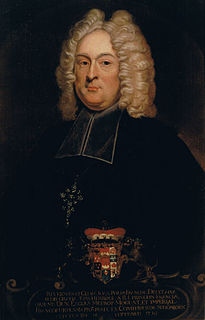
Johann Philipp Franz von Schönborn (1673–1724) was the Prince-Bishop of Würzburg from 1719 to 1724. His principal claim to fame is his commissioning of the Würzburg Residence, a major work of Baroque architecture.

Franz Ludwig Freiherr von Erthal was the prince-bishop of Würzburg and Bamberg from 1779 until his death. He was buried at the Würzburg Cathedral.

Würzburg Cathedral is a Roman Catholic cathedral in Würzburg in Bavaria, Germany, dedicated to Saint Kilian. It is the seat of the Bishop of Würzburg and has served as the burial place for the Prince-Bishops of Würzburg for hundreds of years. With an overall length of 103 metres, it is the fourth largest Romanesque church building in Germany, and a masterpiece of German architecture from the Salian period. Notable later additions include work by Tilman Riemenschneider and Balthasar Neumann. The cathedral was heavily damaged by British bombs in March 1945 but rebuilt post-World War II.

Bundesstraße 22 is a German federal highway that runs from Würzburg in Lower Franconia, through the Upper Franconian cities of Bamberg and Bayreuth and the Upper Palatine town of Weiden, to Cham. The highway acts as a bypass for the Upper Franconian villages of Seybothenreuth and Speichersdorf as well as the Upper Palatine towns of Kemnath, Erbendorf, Oberviechtach and Rötz, running past Cham (Oberpfalz), where it joins the B 20 and B 85 highways.

Johann Gottfried von Aschhausen (1575–1622) was the Prince-Bishop of Bamberg from 1609 to 1622 and Prince-Bishop of Würzburg from 1617 to 1622.

Franz von Hatzfeld was the Prince-Bishop of Würzburg from 1631 to 1642 and the Prince-Bishop of Bamberg from 1633 to 1642.

Peter Philipp von Dernbach (1619–1683) was the Prince-Bishop of Bamberg from 1672 to 1683 and Prince-Bishop of Würzburg from 1675 to 1683.
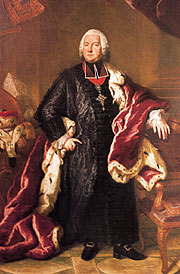
Adam Friedrich Graf von Seinsheim (1708–1779) was the Prince-Bishop of Würzburg from 1755 to 1779 and Prince-Bishop of Bamberg from 1757 to 1779.

Christoph Franz von Hutten (1673–1729) was the Prince-Bishop of Würzburg from 1724 to 1729.
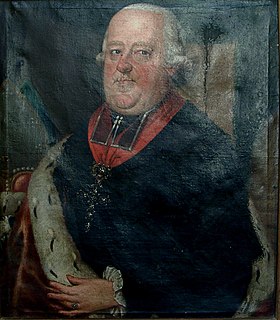
Georg Karl Ignaz Freiherr von Fechenbach zu Laudenbach (1749–1808) was the last Prince-Bishop of Würzburg, holding office from 1795 until 1803, when the Prince-Bishopric of Würzburg was mediatised to the Electorate of Bavaria. He continued to serve as Bishop of Würzburg, though without temporal power, until his death. He was also Bishop of Bamberg from 1805 until his death.
Franz Konrad or Conrad may refer to:

The Marienkirche, Würzburg is a chapel located in the inner court of Marienberg Fortress in Würzburg, Bavaria. The first Christian church at this location was built in 706 by Duke Hedan II. The structure of today's building can be traced back to the early 11th century. It is the oldest church in Würzburg and the oldest building in the fortress.


